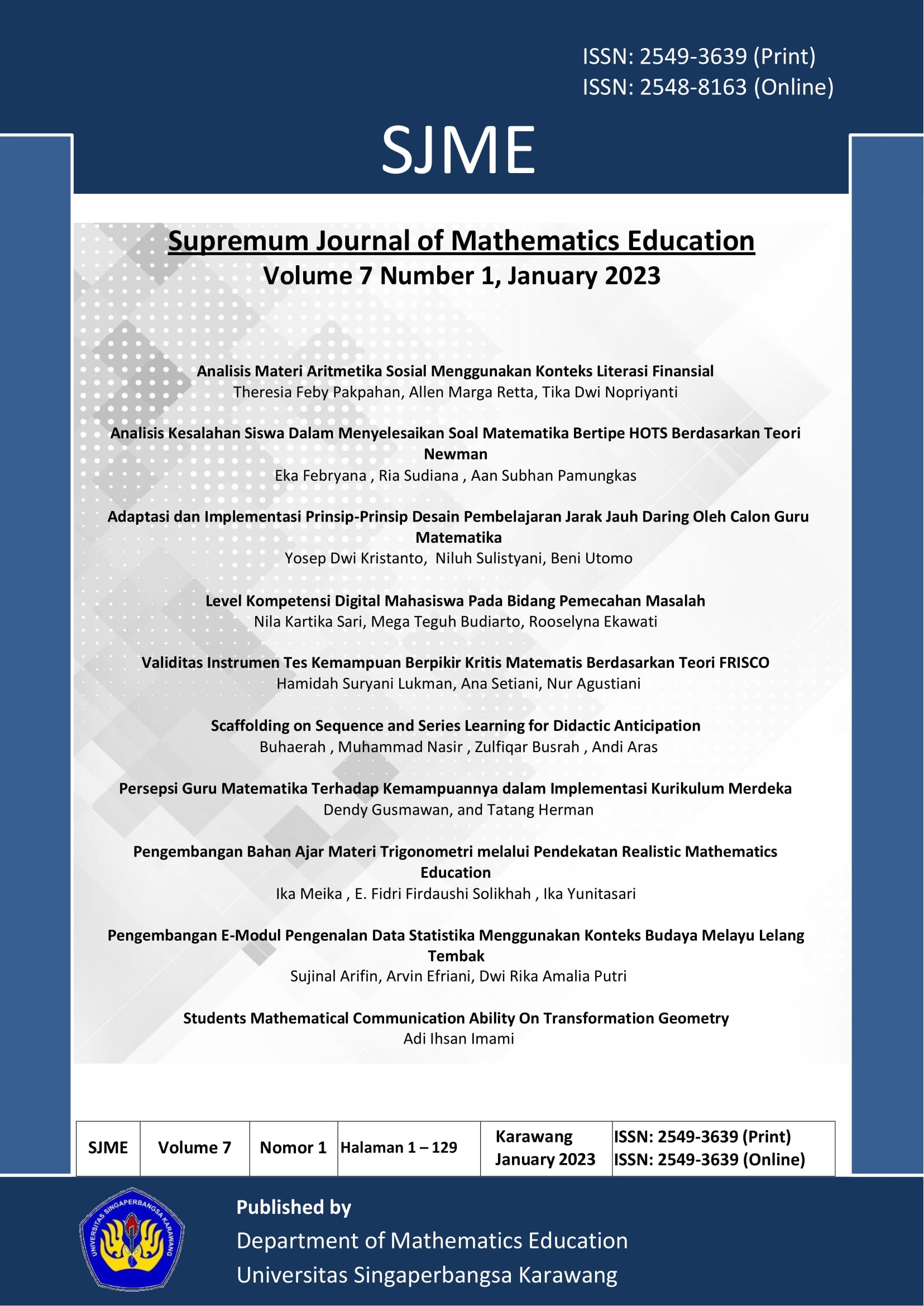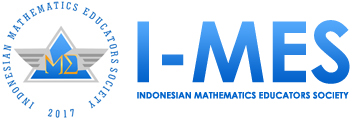Pengembangan Bahan Ajar Materi Trigonometri melalui Pendekatan Realistic Mathematics Education
DOI:
https://doi.org/10.35706/sjme.v7i1.7190Abstract
The purpose of this study was to develop teaching materials in the form of LKPD trigonometry materials through the RME approach. Research and development is carried out using the Design Based Research (DBR) method with the Plomp development model consisting of three stages, namely: Preliminary Research, Prototyping Stages and Assessment. This article is part of a research entitled "Development of Trigonometry Teaching Materials through Realistic Mathematics Education Approaches", which contains results and discussions at the preliminary research and prototyping stages (up to prototype-2). The research was conducted at MAS Mathla'ul Anwar Center. The research begins with a needs analysis in the field, then continues with the creation of LKPD. The worksheets are validated by material experts and linguists. The validation results from material experts are 91.83% with a very valid category and from linguists the validation percentage is 75% with a fairly valid category and needs minor revisions. The results of the LKPD validation by the validator show that the LKPD is feasible to be tested on students with an average percentage of 86.25% with a very valid category. The revision of the validation stage resulted in prototype-1. The small group test was carried out on students of class XI IPA 2. The small group test produced prototype-2 which was ready to be used in classroom learning.
Downloads
References
Dinar, I. (2019). Penerapan Bahan Ajar Matematika Berbasis Rme Terhadap Kemampuan Pemahaman Konsep Matematis Dan Self-Confidence Siswa Pada Materi Trigonometri. JURNALPEKA, 2(2), 49–55. https://doi.org/10.37150/jp.v2i2.1116
Gazali, R. Y. (2016). Pengembangan Bahan Ajar Matematika untuk Siswa SMP Berdasarkan Teori Belajar Ausubel Development of Mathematics Teaching Material for Junior High School Students Based on Ausubel Learning Theory. 11, 182–192.
Haq, A. (2021). Pengembangan LKPD Berbasis Realistic Mathematics Education Pada Materi Sistem Persamaan Linear Dua Variabel untuk Peserta Didik Kelas VIII SMPN 2 Batusangkar. In Skripsi pada Jurusan Tadris Matematika Fakultas Tarbiyah dan Ilmu Keguruan IAIN Batusangkar. https://ecampus.imds.ac.id/xmlui/handle/123456789/21465
Kemendikbud, 2014. Press Workshop : Implementasi Kurikulum 2013, paparan Menteri Pendidikan dan Kebudayaan (2014).
Kennedy-Clark, S. (2013). Research by Design: Design-Based Research and the Higher Degree Research Student. Journal of Learning Design, 6(2), 26–32. https://eric.ed.gov/?id=EJ1018597
Maryamah, I., Anriani, N., & Fathurrohman, M. (2019). Pengembangan Bahan Ajar Materi Pythagoras yang Berorientasi pada Kompetensi Abad 21 untuk Guru SMP. SJME (Supremum Journal of Mathematics Education), 3(1), 32–43. https://doi.org/10.35706/sjme.v3i1.1490
Meika, I., Suryadi, D., & Darhim, D. (2019). Analysis of students’ mathematical modelling ability in solving combination problems using local instruction theory teaching materials. Journal of Physics: Conference Series, 1157(4). https://doi.org/10.1088/1742-6596/1157/4/042082
Pratidiana, D., & Junaedi, A. (2022). Penggunaan Aplikasi Cymath Pada Pembelajaran Aljabar Untuk Meningkatkan Minat Belajar Siswa Kelas 11. MENDIDIK: Jurnal Kajian Pendidikan Dan Pengajaran, 8(1), 167–174. https://doi.org/10.30653/003.202281.229
Puspitasari, T., Syamsuri, & Santosa, C. A. H. F. (2021). Konstruksi Konsep Trigonometri Bagi Siswa Sma Berdasarkan Teori Apos. Wilangan: Jurnal Inovasi Dan Riset Pendidikan Matematika, 2(4), 178–195. http://www.jurnal.untirta.ac.id/index.php/wilangan
Rahman, M. H., Luthfiana, M., & Yanto, Y. (2017). Pengembangan Lembar Kerja Siswa Dengan Pendekatan Pendidikan Matematika Realistik Indonesia Pada Materi Trigonometri Kelas X Sma Negeri 1 Lubuklinggau. In Jurusan Matematika dan Ilmu Pengetahuan Alam STKIP-PGRI.
Rahmawati, S. (2021). Pengembangan Lembar Kerja Peserta Didik (LKPD) Berbasis Realistic Mathematics Education (RME) Untuk Mendukung Peningkatan Kemampuan Berpikir Kreatif Matematis Siswa Pada Materi Sistem Persamaan Linear Dua Variabel (SPLDV). Universitas Muhammadiyah Surakarta.
Rifa’i, R. (2015). Penggunaan Model Cooperative Script Terhadap Kemampuan Pemahaman Dan Komunikasi Matematis Siswa. Jurnal Kajian Pendidikan Dan Pengajaran, 1(1), 30. https://doi.org/10.30653/003.201511.9
Sahrudin, A., & Trisnawati, T. (2018). Pengembangan Metode Problem Based Learning Melalui Permainan Engklek Untuk Meningkatkan Thinking Math Peserta Didik Ma Global School. SJME (Supremum Journal of Mathematics Education), 2(1), 32–43. https://doi.org/10.35706/sjme.v2i1.999
Sari, A., & Yuniati, S. (2018). Penerapan Pendekatan Realistic Mathematics Education (RME) Terhadap Kemampuan Pemahaman Konsep Matematis. Jurnal Cendekia: Jurnal Pendidikan Matematika, 2(2), 71–80. https://doi.org/10.31004/cendekia.v2i2.49
Sartika, N. S., & Mauladaniyati, R. (2021, Desember). Analysis of Prospective Mathematics Teachers' Reading Interest Through E-Book for Geometry Systems Course in New Normal Era. In International Conference on Educational Studies in Mathematics (ICoESM 2021) (pp. 353-359). Atlantis Press.
Schemme, D., & Novak, H. (2017). Gestaltungsorientierte Forschung - Basis für soziale Innovationen erprobte Ansätze im Zusammenwirken von Wissenschaft und Praxis.
Tamur, M., Juandi, D., & Adem, A. M. G. (2020). Realistic Mathematics Education in Indonesia and Recommendations for Future Implementation: A Meta-Analysis Study. JTAM | Jurnal Teori Dan Aplikasi Matematika, 4(1), 17. https://doi.org/10.31764/jtam.v4i1.1786
Yunitasari, I. (2018). Desain Bahan Ajar Matematika dengan Pendekatan Metakognitif Berbasis Pemecahan Masalah pada Pokok Bahasan Bangun Ruang Sisi Datar [Universitas Pasundan Bandung]. In Universitas Pasundan scienti. http://repository.unpas.ac.id/40251/
Downloads
Published
How to Cite
Issue
Section
License

This work is licensed under a Creative Commons Attribution-ShareAlike 4.0 International License.
Authors who publish with this journal agree to the following terms:
- Authors retain copyright and grant the journal right of first publication with the work simultaneously licensed under a Creative Commons Attribution License that allows others to share the work with an acknowledgment of the work's authorship and initial publication in this journal.
- Authors are able to enter into separate, additional contractual arrangements for the non-exclusive distribution of the journal's published version of the work (e.g., post it to an institutional repository or publish it in a book), with an acknowledgment of its initial publication in this journal.
- Authors are permitted and encouraged to post their work online (e.g., in institutional repositories or on their website) prior to and during the submission process, as it can lead to productive exchanges, as well as earlier and greater citation of published work (See The Effect of Open Access).











